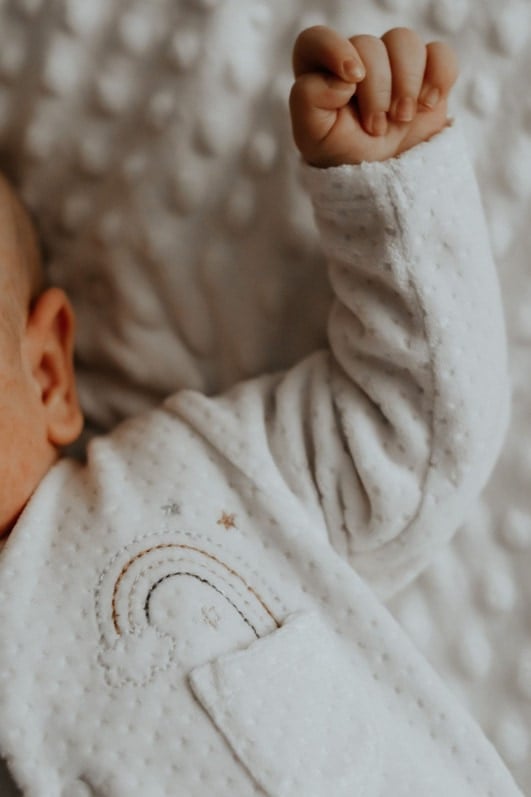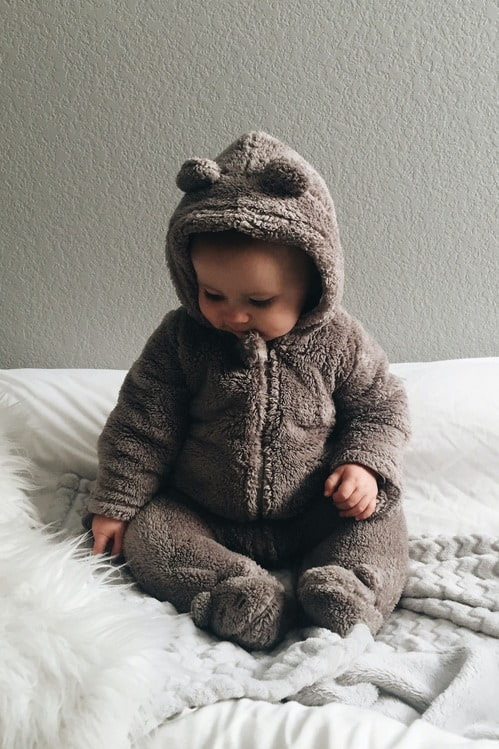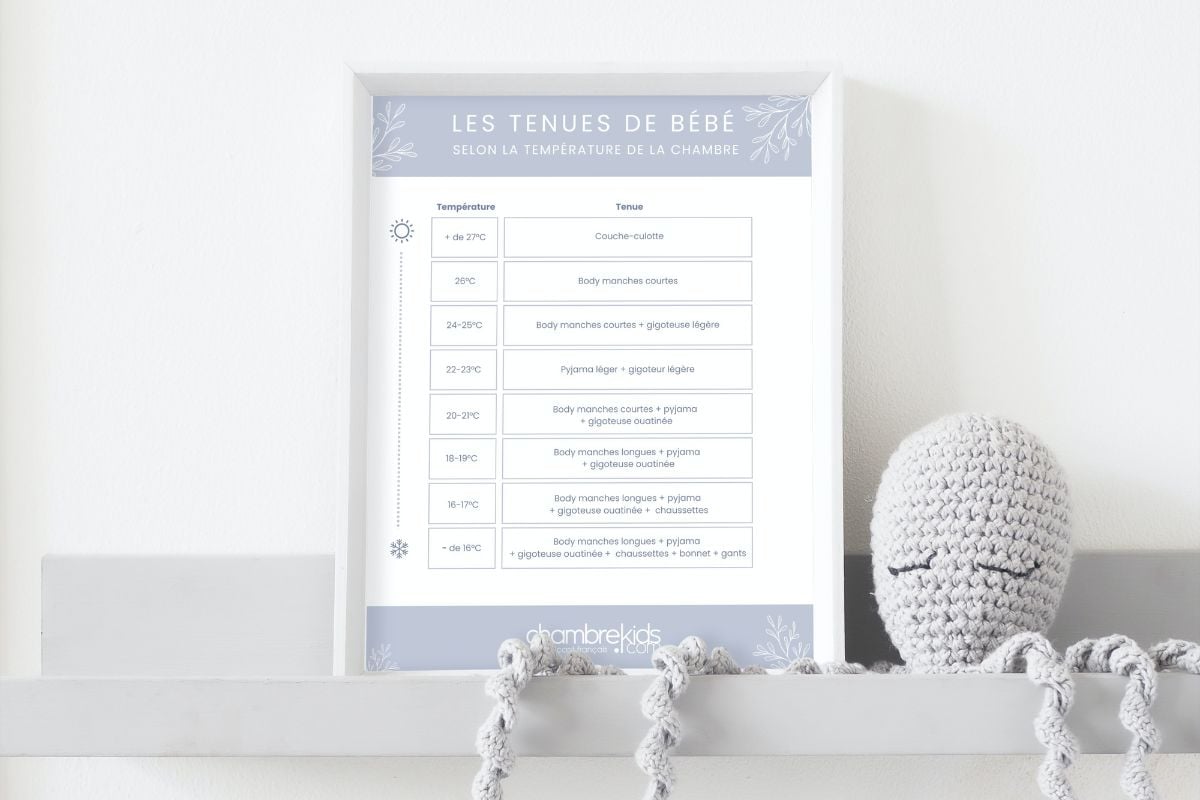How to dress baby at night?
Categories:
Advice
 Choosing the right baby blanket dimensions according to season and age
Choosing the right baby blanket dimensions according to season and age
 How to attach a headboard (with or without drilling): quick and effective soluti
How to attach a headboard (with or without drilling): quick and effective soluti
 Waterproof sheet or mattress protector: the best solution by age group
Waterproof sheet or mattress protector: the best solution by age group
 27 Original, Useful, and Trendy Christmas Ideas for Teens 2025
27 Original, Useful, and Trendy Christmas Ideas for Teens 2025
 Christmas Activities for Baby: Creative Ideas for Home & Daycare
Christmas Activities for Baby: Creative Ideas for Home & Daycare
Wondering how to dress your baby at night? Don't panic, we're here to help.
Simply follow these three essential rules:
By following these simple guidelines, you'll give your baby peaceful nights, away from risks of overheating or discomfort.
Follow our step-by-step guide and you'll know how to dress your baby for both comfort and safety.
All recommendations regarding baby clothing should be considered according to your child's nature. We are all more or less sensitive to cold or heat, this characteristic is innate. At comparable temperatures, with the same clothes and bedding, two babies never react exactly the same way, which is why how to dress baby at night depends primarily on your child's nature.

Besides clothing, you need to consider the baby's bedding and accessories. The choice of baby mattress and its composition plays a role in temperature regulation. The same goes for sheets, duvet, and pillow. Materials retain heat differently. This can be decisive depending on the region where you live: you don't necessarily buy the same bedding and accessories if you live in the north or south of France.
In all cases, the materials you select must be breathable. If your child is active or if it's a bit too warm, the mattress and sheets must be able to absorb sweat for the child's comfort and health.
There is an indicator expressing the thermal capacity of clothing. It's called TOG for Thermal Overall Grade. The TOG of sleeping bags typically ranges between 0.5 and 4. The lowest index is for summer clothing, the maximum rating for winter.
The ideal temperature for a baby's room is between 18 and 20°C. A sleeping bag with TOG 2 is then recommended.
Temperature isn't the only criterion you should consider when deciding how to dress baby at night. The humidity level in the room also affects your child's comfort. It should ideally be 50%. This rate fluctuates with the seasons and differs from region to region.
To maintain balance if you notice it's deviating too much from the average, equip the room with a humidifier. If the air is too dry, there are also simple tricks that help you avoid unnecessary investment:
hang your laundry to dry in the baby's room;
if the room is adjacent to the bathroom, leave the door open after showering or bathing;
in winter, place a pot of hot water on the floor before bedtime to let it evaporate;
in winter, install a saturator, which is a small water reservoir that attaches to the room's radiator and humidifies the air through simple water evaporation.
As temperatures rise during summer, you need to adapt their clothing to avoid sweating and night wakings. Above 22°C, remove the bodysuit and opt for light pajamas with a sleeping bag that doesn't exceed 0.5 TOG. If the temperature exceeds 24 or 25°C, it's better to replace the pajamas with a simple short-sleeved bodysuit.
During a heatwave and when the temperature exceeds 26°C, you can do without a sleeping bag. Let your child sleep without clothes, just with their diaper. You must avoid them sweating too much at all costs, as babies become dehydrated quickly.
%20(1).jpg)
Babies struggle to regulate their temperature until the age of 2 to 3 years. Moreover, since they cannot clearly express their discomfort, parents must take all precautions to choose their nighttime wardrobe well, as well as their bedding, duvet, and sheets.
The first precaution for a baby's room is to keep a thermometer there permanently. It should be placed as close as possible to the baby's bed, away from windows and heat sources to avoid inaccurate readings.
If you haven't bought your baby monitor yet, know that there are sophisticated models that include a thermometer function. They can alert you when the temperature exceeds the lower and upper thresholds you've set.
The outside temperature influences the ambient temperature of your house or apartment. You need to learn to decode the signs showing whether your child is too hot or too cold, to decide how to dress your baby at night.
The extremities — hands and feet — are reliable indicators. They may be cooler when the temperature is not very high, without affecting the baby's comfort. However, they should not be too cold.
The nape of the neck is an even more precise indicator. It should be warm to the touch, but not damp, which would indicate that your baby is too hot. If it feels cold when you touch it, their clothing is insufficient. It's better to add a layer of clothing or a blanket to maintain a more comfortable temperature.
Excessive heat is also indicated by sweating around the thighs or belly, as well as red cheeks. Conversely, pale complexion, cold extremities, and cold belly indicate that the baby needs more covering.
Other signs showing inappropriate temperature are expressed through the child's behavior: crying, prolonged drowsiness, apathy, nervousness, etc.
Hot nights require a minimalist approach. Choose technical textiles like gauze cotton or linen, which wick away moisture while allowing air circulation. A simple tip: place a damp cloth in front of a fan to naturally cool the room without air conditioning.
You can recognize truly breathable fabric by touch: the material should allow a noticeable airflow. Oeko-Tex certifications guarantee the absence of irritating chemicals, crucial for sensitive skin during periods of increased sweating.
The three-layer maximum technique (bodysuit, pajamas, sleeping bag) allows easy outfit adjustment. Prefer layerable materials like merino wool under corduroy pajamas for rooms below 18°C.
Wool booties and fingerless mittens should be removed at the first signs of palm sweating. Monitor compression areas to avoid irritation.
During fever episodes, immediately lighten clothing by half a level (going from 3 to 2 layers). A long-sleeve bodysuit in organic cotton combined with light pajamas is usually sufficient for a room at 20°C.
For premature babies, continue using wool bodysuits until 3 months after the theoretical term. Immature thermoregulation requires hourly monitoring in the first weeks, with layer adjustments to the quarter degree.
For a night expected to be 15°C in the evening but rising to 19°C, use a TOG 1.5 sleeping bag with ventilated zipper. Keep an extra folded layer near the bed for quick intervention around 2 AM.
The ideal emergency kit includes: a long-sleeve bodysuit, a pair of fleece booties, a light sleeping bag, and muslin swaddles. Store it in a cotton bag within reach for unexpected variations.
Here's an indicative chart of nighttime clothing based on temperature:
There comes an age when baby can finally do without a sleeping bag. Depending on the child, this is between 18 months and 3 years. If you feel they're comfortable in their sleeping bag, there's no reason to take it away. It remains the best solution for particularly active babies during the night, as it ensures you won't find them uncovered in the morning.
In any case, pediatricians recommend not using a duvet before 18 months of age. There is both a risk of suffocation and duvet slippage for more active children.
Generally, it's your baby who indicates when it's time for the transition. They will try everything to get rid of their sleeping bag in which they start feeling confined, and neither snaps nor zippers will stop them!
The transition to a sleeping bag is also related to when you change their bed to provide more spacious sleeping arrangements. Additionally, the sleeping bag is not suitable for potty training, another sign that it's time to stop using it.
We recommend switching to a duvet during the warm season. Your baby will tend to uncover themselves during the first few nights, which matters less in summer.
Remember that each child is unique. Your first task is to observe your baby to know if their clothing needs adjustment to ensure optimal comfort.

Nighttime overheating disrupts the infant's automatic wake-up mechanisms, increasing the risk of respiratory distress. This thermal disturbance explains why 20% of SIDS cases occur in environments overheated above 22°C.
The latest health recommendations emphasize the balance between light clothing and controlled temperature. A recent study shows that following thermal guidelines reduces serious respiratory incidents by 40% in infants under 6 months.
Position the baby bed 50 cm away from radiators and windows, on a firm surface without soft mattresses. Traditional crib bumpers triple the risk of suffocation - prefer openwork muslin models firmly secured.
Heavy blankets alter spontaneous mobility. Systematically replace them with a baby sleeping bag adapted to the child's weight, with adjustable armholes to prevent riding up.
Check skin temperature every 2-3 hours by lightly touching the nape with the back of your hand. Connected monitors measuring pajama humidity usefully complement these checks, without replacing direct observation.
Prefer under-mattress movement sensors to video models to limit light disturbance. Adjust sound alerts to a level that allows hearing natural crying.
From 0 to 3 months, maintain increased vigilance on thermoregulation with hourly checks. The transition to a big kid bed requires gradual adaptation: start with naps in the new bed around 18 months.
For early risers, provide an easily removable extra layer without full awakening. Back-zip secured pajamas allow clothing autonomy from age 2 while limiting strangulation risks.

